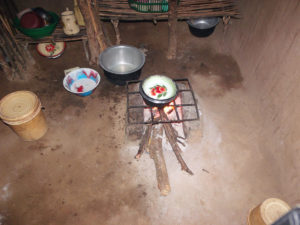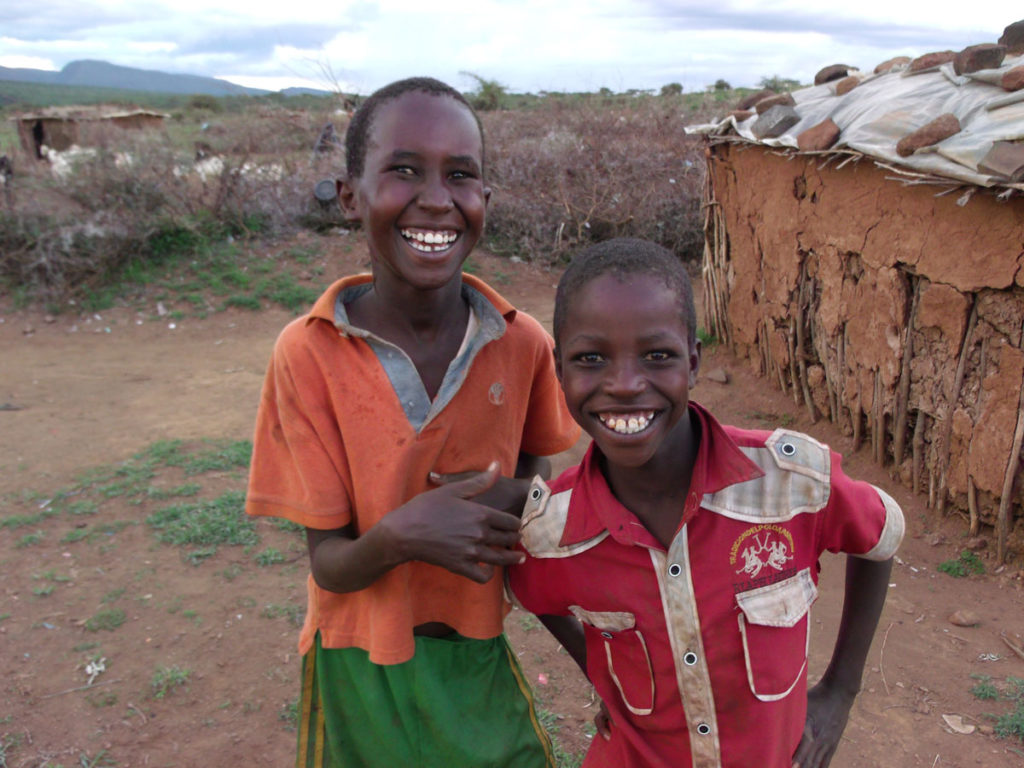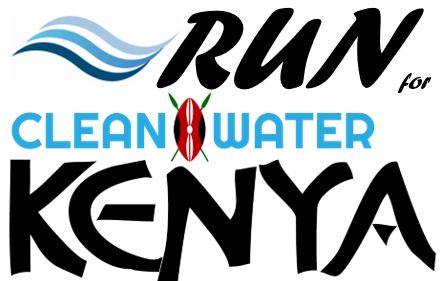Typical materials used in the construction of Maasai huts, or Bomba, are cow dung, mud, sticks, grass, human urine and ash. The walls are made of these materials and the roof can be made from almost anything: sticks, reeds, tin or anything that will lay flat. The walls are built to the height of the woman who builds it. The woman always builds the house because it is HERS. Maasai women tend to be shorter than the men – some much shorter – and so it’s not uncommon for the men as they grow older to develop lower back problems due to the many years of being bent over while indoors.
 I was invited by a lovely young Maasai woman into her home while on my first visit to Maasai Land delivering medical supplies to the Ewaso Clinic. I learned first hand how low the roofs can be on Maasai bombas. As I followed the lady of the house through the door I practically had to bend over and touch the ground. The door is small and an average person such as myself, I’m 5’10” tall, must stoop down to enter. I remained bent over for the entire tour.
I was invited by a lovely young Maasai woman into her home while on my first visit to Maasai Land delivering medical supplies to the Ewaso Clinic. I learned first hand how low the roofs can be on Maasai bombas. As I followed the lady of the house through the door I practically had to bend over and touch the ground. The door is small and an average person such as myself, I’m 5’10” tall, must stoop down to enter. I remained bent over for the entire tour.
During my short tour in her home I saw first-hand how the Maasai live and learned a little bit about their culture. There is a small kitchen area that normally consists of 3 stones or bricks on the floor laid in a U-shaped pattern with a grill laid on top. That’s the stove. Off to the side would be a small partition holding the sticks for the cooking fire. Another partition would be where the woman would sleep with her young children – boys up until around the age of 5 – when they would go to live with their father in his hut, if dad had more than one wife, which many do. If there are no children the man and woman would have their own beds made from sticks raised a few inches off the ground and placed on opposite sides of the hut many times partitioned by an open wall made from sticks. There are no bathrooms.
 As the man’s wealth would grow over time from the many cattle and goats he would acquire he could purchase wives and then each wife would build her own hut and live separately from her husband. The first wife would have the largest hut, the 2nd a smaller one, the 3rd smaller and so on. Maasai men spend many months a year ‘on-the-road’ so to speak, herding their cattle and goats to any fresh grasslands they can find, many times following the rains and the seasons. One village I visited I was told by the women there that they had not seen their husbands and male children in almost 6 months due to the drought and lack of grass for their livestock. Livestock is everything to the Maasai warrior. His wealth is determined NOT by how many wives he has but rather by how many cattle and goats and children he has. Having too much of one and not enough of the other and a Maasai warrior would be considered ‘poor.’ The Maasai are known as ‘Pastoralists.’ They are semi-nomadic herders that roam between Kenya, Tanzania and Uganda.
As the man’s wealth would grow over time from the many cattle and goats he would acquire he could purchase wives and then each wife would build her own hut and live separately from her husband. The first wife would have the largest hut, the 2nd a smaller one, the 3rd smaller and so on. Maasai men spend many months a year ‘on-the-road’ so to speak, herding their cattle and goats to any fresh grasslands they can find, many times following the rains and the seasons. One village I visited I was told by the women there that they had not seen their husbands and male children in almost 6 months due to the drought and lack of grass for their livestock. Livestock is everything to the Maasai warrior. His wealth is determined NOT by how many wives he has but rather by how many cattle and goats and children he has. Having too much of one and not enough of the other and a Maasai warrior would be considered ‘poor.’ The Maasai are known as ‘Pastoralists.’ They are semi-nomadic herders that roam between Kenya, Tanzania and Uganda.
If you were wondering, the bombas are cool in the summer and warm in the winter due to the thickness of the walls. And no, they don’t have the aroma consistent with cow dung and urine. They let it cure before moving in. The huts are basic living providing shelter from the hot summers and cold rainy seasons and a place to socialize. They do the job and in many ways are quite comfortable.
Did you enjoy this article?
We will continue to share our experiences with our readers as we travel the Kenyan Rift Valley. If you enjoy learning more about the Maasai and their lives, please consider a donation that will help us deliver them clean water systems.


Recent Comments